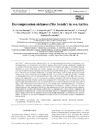Identificador persistente para citar o vincular este elemento:
https://accedacris.ulpgc.es/jspui/handle/10553/45732
| Título: | Decompression sickness ('the bends') in sea turtles | Autores/as: | García-Párraga, D. Crespo-Picazo, J. L. Bernaldo de Quirós Miranda, Yara Cervera, V. Martí-Bonmati, L. Diaz Delgado, Josue Arbelo Hernández, Manuel Antonio Moore, M. J. Jepson, P. D. Fernández Rodríguez, Antonio Jesús |
Clasificación UNESCO: | 310907 Patología | Palabras clave: | Decompression sickness Sea turtles Sea turtle diving physiology |
Fecha de publicación: | 2014 | Editor/a: | 0177-5103 | Publicación seriada: | Diseases of Aquatic Organisms | Resumen: | Decompression sickness (DCS), as clinically diagnosed by reversal of symptoms with recompression, has never been reported in aquatic breath-hold diving vertebrates despite the occurrence of tissue gas tensions sufficient for bubble formation and injury in terrestrial animals. Similarly to diving mammals, sea turtles manage gas exchange and decompression through anatomical, physiological, and behavioral adaptations. In the former group, DCS-like lesions have been observed on necropsies following behavioral disturbance such as high-powered acoustic sources (e.g. active sonar) and in bycaught animals. In sea turtles, in spite of abundant literature on diving physiology and bycatch interference, this is the first report of DCS-like symptoms and lesions. We diagnosed a clinico-pathological condition consistent with DCS in 29 gas-embolized loggerhead sea turtles Caretta caretta from a sample of 67. Fifty-nine were recovered alive and 8 had recently died following bycatch in trawls and gillnets of local fisheries from the east coast of Spain. Gas embolization and distribution in vital organs were evaluated through conventional radiography, computed tomography, and ultrasound. Additionally, positive response following repressurization was clinically observed in 2 live affected turtles. Gas embolism was also observed postmortem in carcasses and tissues as described in cetaceans and human divers. Compositional gas analysis of intravascular bubbles was consistent with DCS. Definitive diagnosis of DCS in sea turtles opens a new era for research in sea turtle diving physiology, conservation, and bycatch impact mitigation, as well as for comparative studies in other air-breathing marine vertebrates and human divers. | URI: | https://accedacris.ulpgc.es/handle/10553/45732 | ISSN: | 0177-5103 | DOI: | 10.3354/dao02790 | Fuente: | Diseases Of Aquatic Organisms [ISSN 0177-5103], v. 111 (3), p. 191-205 |
| Colección: | Artículos |
Citas SCOPUSTM
85
actualizado el 08-jun-2025
Citas de WEB OF SCIENCETM
Citations
70
actualizado el 08-jun-2025
Visitas
142
actualizado el 15-jun-2024
Descargas
166
actualizado el 15-jun-2024
Google ScholarTM
Verifica
Altmetric
Comparte
Exporta metadatos
Los elementos en ULPGC accedaCRIS están protegidos por derechos de autor con todos los derechos reservados, a menos que se indique lo contrario.
